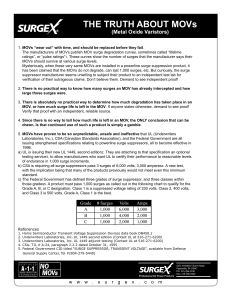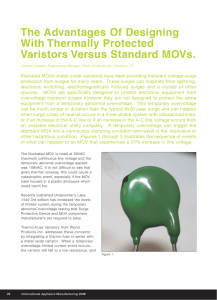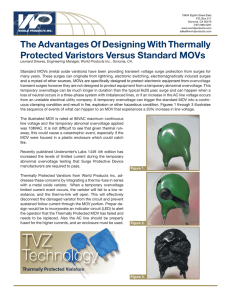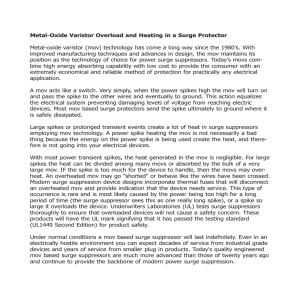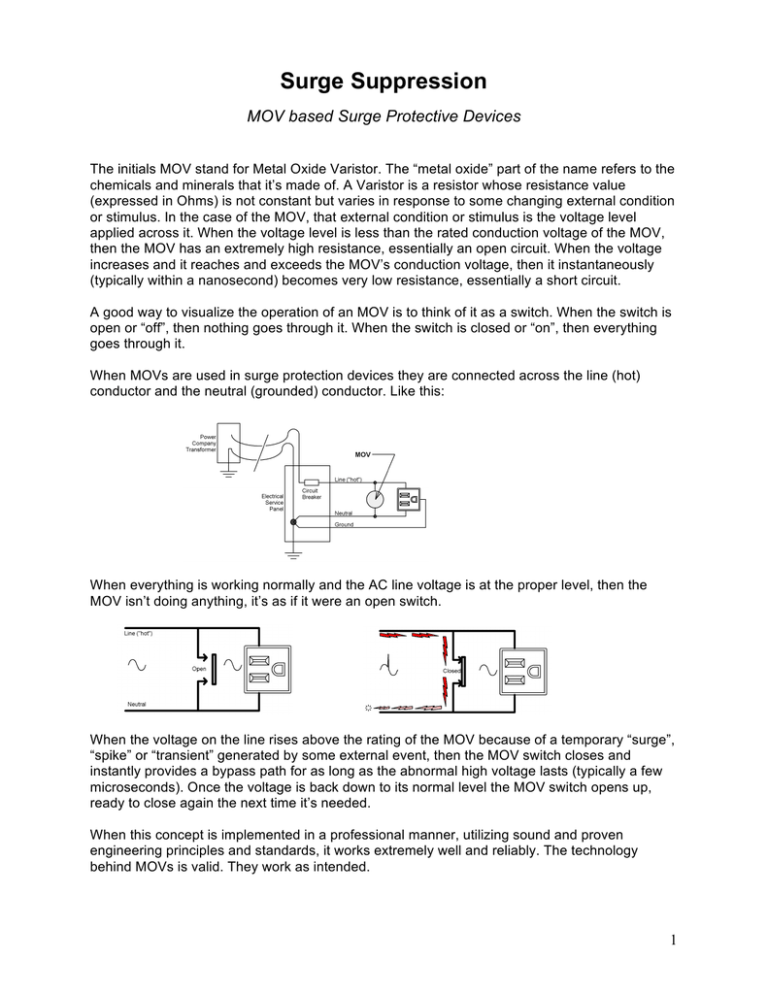
Surge Suppression
MOV based Surge Protective Devices
The initials MOV stand for Metal Oxide Varistor. The “metal oxide” part of the name refers to the
chemicals and minerals that it’s made of. A Varistor is a resistor whose resistance value
(expressed in Ohms) is not constant but varies in response to some changing external condition
or stimulus. In the case of the MOV, that external condition or stimulus is the voltage level
applied across it. When the voltage level is less than the rated conduction voltage of the MOV,
then the MOV has an extremely high resistance, essentially an open circuit. When the voltage
increases and it reaches and exceeds the MOV’s conduction voltage, then it instantaneously
(typically within a nanosecond) becomes very low resistance, essentially a short circuit.
A good way to visualize the operation of an MOV is to think of it as a switch. When the switch is
open or “off”, then nothing goes through it. When the switch is closed or “on”, then everything
goes through it.
When MOVs are used in surge protection devices they are connected across the line (hot)
conductor and the neutral (grounded) conductor. Like this:
When everything is working normally and the AC line voltage is at the proper level, then the
MOV isn’t doing anything, it’s as if it were an open switch.
When the voltage on the line rises above the rating of the MOV because of a temporary “surge”,
“spike” or “transient” generated by some external event, then the MOV switch closes and
instantly provides a bypass path for as long as the abnormal high voltage lasts (typically a few
microseconds). Once the voltage is back down to its normal level the MOV switch opens up,
ready to close again the next time it’s needed.
When this concept is implemented in a professional manner, utilizing sound and proven
engineering principles and standards, it works extremely well and reliably. The technology
behind MOVs is valid. They work as intended.
1
Several decades ago, when MOVs were a relatively new technology and first became available
in large quantities at reasonable costs, some manufacturers began selling small power strips
that incorporated MOVs for surge and transient protection. That same era experienced widespread sales of personal computers and sophisticated consumer electronics that were (and are)
susceptible to damage from power surges and utility grid disturbances. Naturally, everyone
wanted to protect their equipment so they bought power strips that included “surge
suppression’.
For various reasons, some of the surge suppressor–power strips that were designed and
manufactured in the 1970’s and 1980’s (and even later) were made with low quality and/or
undersized MOVs and lacked the basic safety provisions of fuses and thermal cut-offs that
would prevent them from overheating and becoming a fire hazard under certain fault conditions.
Such products are rare today, although they can still be found. Product safety and installation
standards were developed by several organizations (e.g. Underwriters Laboratories,
www.ul.com; the National Fire Protection Agency [NEC], www.nfpa.org; etc.) who contributed
greatly to refining the industry.
The science behind Metal Oxide Varistors is mature and proven. Dozens of world-class
companies manufacture them by the millions in sizes ranging from pinhead to those that require
a fork truck to lift. The electrical utility industry has been using MOVs to protect substations and
transmission lines for almost half a century. The fact that there is consistent, reliable AC power
in the home and workplace is due, in large part, to MOVs.
Compare the large MOV in the middle photo above to the grouping of MOVs in the photos at left
and right. Many SPD manufacturers design products in a similar way, using multiple identical
MOVs connected in parallel. That’s because using multiple MOVs together increases the level
of protection, while sharing the load of diverting a power surge. For instance (based on the MOV
manufacturer’s documented performance and de-rating data), a single 20mm diameter MOV will
withstand a 6kV, 3kA surge between 2 and 10 times before its failure becomes a real possibility.
Two of the same MOVs connected in parallel will withstand that 3kA surge approximately 50
times. Three MOVs will take that surge about 100 times. Four MOVs will do it about 500 times.
Nine MOVs (as used in Lowell Advanced Surge Suppression products with TCR™ technology)
will handle up to 5000 6kV, 3kA surges.
Under normal conditions, MOVs are like open switches.
2
When a surge happens, they all close or “turn on” at the same time and each does their share in
getting rid of the surge.
Sometimes electronic components fail. MOVs are no exception. On the rare occasion when they
fail they usually become a short circuit, that is, they don’t go open or “turn off” after the surge
has subsided. They stay closed or “on” until the current flowing through them causes them to
heat up to the point that they literally break apart, thereby becoming an open circuit again,
permanently this time. Because of that failure mode, MOVs (or groups of MOVs) should always
have some provision for disconnecting them from the power line before they self-destruct to the
point of harming anything else. This is usually accomplished with fuses, thermal cut-offs (TCOs)
or a combination of both.
That’s why having parallel MOVs in the design is a good idea. Should one fail then the others
are there to continue providing protection, like this:
In a redundant design with multiple MOVs, surge protection is maintained at the same level
despite the failure of one (or even more than one) MOV. However, should one or more MOV
fail, that will put an extra load on the remaining MOVs which can decrease their life span.
Because of this possibility, well designed surge protective devices provide some sort of failure
notification, usually in the form of an LED indicator. The LED indicator is typically ‘on’ when the
protection circuitry is working properly.
As you can see, well designed surge protective devices that utilize multiple MOVs in a load
sharing arrangement as explained above will rarely, if ever, fail completely and then only under
the most extreme conditions.
© 2012 Lowell Manufacturing Company 100 Integram Drive, Pacific, Missouri 63069 U.S.A. All rights reserved.
3

